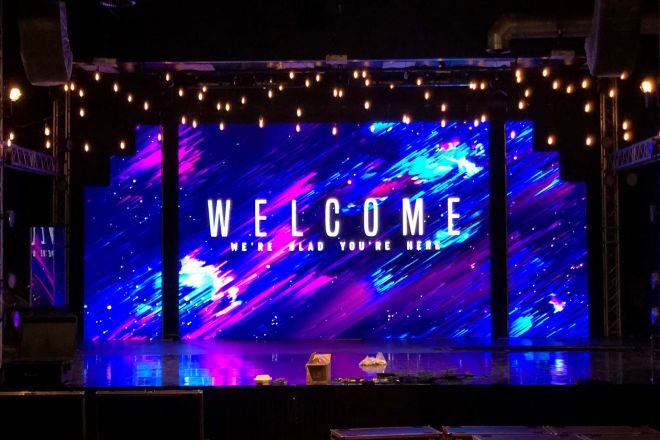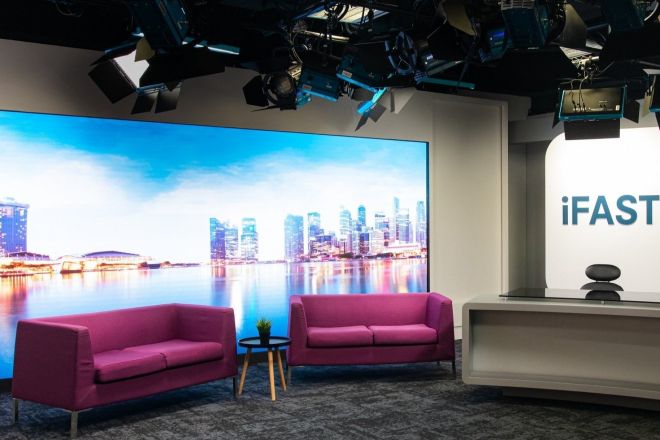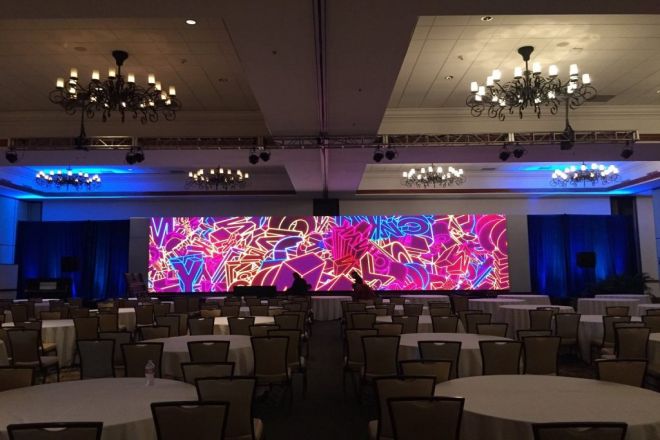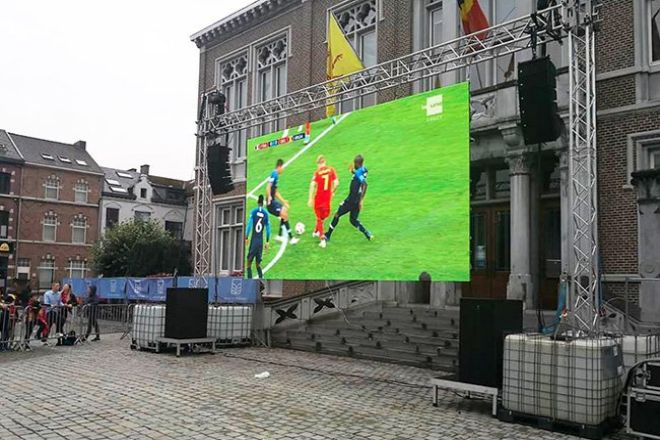소개

과학기술의 급속한 발전으로 인해, 발광 다이오드 표시 스크린 have become an important tool for modern information display and are widely used in various fields such as commercial advertising, conferences and exhibitions, sports venues, and public information releases. Due to its unique display effect and flexibility, customized LED displays have become the first choice for more and more users.
However, during the customization process, users often face a series of problems and confusion. This article will provide detailed answers to common questions about LED display customization.
1. Why is LED display a customized product?
The reason why the LED display screen is a customized product is as follows:
가장 먼저, customized LED displays can meet the specific requirements of different occasions and needs. Each application site and purpose may have unique requirements for display screen size, resolution, brightness, color, and other parameters.
For example, commercials may require bright, high-resolution displays to attract customers, while sports venues may require large, wide-viewing displays to ensure viewers can clearly see the game. Through customization, you can ensure that the parameters and configuration of the display fully meet the actual application requirements, thereby achieving the best display and use effects.
둘째, customized LED displays can better adapt to the installation environment and space constraints. Different installation sites may have different space sizes, structural features, and viewing distances, so it is necessary to customize a display that meets the requirements of the installation environment.
For example, in a limited installation space, a display screen of appropriate size can be customized to ensure installation convenience and visual effects.
게다가, customized LED displays can also achieve some special functions and effects. According to customer needs, LED displays with specific functions can be customized, such as remote control, content management, brightness adjustment, etc.
At the same time, some special effects can also be customized, such as seamless splicing, dynamic image playback, etc., to make the display more attractive and practical.
마지막으로, customized LED displays also reflect the satisfaction of personalized needs. Different customers may have different aesthetic preferences and brand images. By customizing the appearance, color, and logo of the display, the customer’s personality and brand image can be better displayed.
2. What materials do I need to prepare if I customize an LED display?

When customizing an LED display, you usually need to prepare the following materials:
- Design documents and parameter requirements:
First, you need to provide design drawings or sketches of the display screen to clarify the basic parameters, such as the size, shape, and resolution of the display screen. If you have special display needs, such as specific pixel spacing, brightness, contrast, or color requirements, you also need to make this clear.
- Installation environment information:
Provide detailed information about the installation environment, including installation location, viewing distance, ambient light conditions, etc. This information helps determine the brightness, viewing angle, and other parameters of the display to ensure the best display effect in various environments.
- Power and signal interface requirements:
You need to clarify the power access method and signal interface type of the display (such as HDMI, DVI, DisplayPort, etc.). This information is critical to the display’s power design and signal transmission.
- Brand and performance requirements:
If you have specific requirements for the brand, performance, or quality of the display, you need to inform us clearly before customizing. This helps suppliers provide you with products that meet your needs.
- Budget limit:
Providing your budget range will help suppliers consider cost factors during the customization process and provide you with the most cost-effective product solution.
- Contracts and agreements:
During the customization process, you need to sign a contract or agreement with the supplier to clarify the rights and obligations of both parties and ensure the smooth progress of the customization process.
Please note that the exact materials you need to prepare may vary depending on your customization needs and the requirements of your supplier. Before customizing, it is recommended to communicate in detail with the supplier to clarify the needs and expectations of both parties and ensure the smooth progress of the customization process.
At the same time, choosing suppliers with rich experience and good reputations is also the key to ensuring the quality of customization.
3. Is a customized LED display very expensive?
The price of a customized LED display does not have to be very expensive. It is affected by many factors, so the price will vary.
가장 먼저, size is an important determinant of the price of custom LED displays. Large-sized screens require more LED lamp beads and a more complex manufacturing process, so the cost will increase accordingly. Therefore, if your customized LED display is larger in size, the price may be relatively high.
둘째, dot spacing is also a key factor affecting price. LED displays with smaller pixel pitches have higher resolution and clearer display effects, but this also comes with a higher price. High-end LED displays, especially small-pitch LED screens such as P1.5 and below, may be very expensive because they are more difficult to manufacture and have higher technical requirements.
게다가, other factors, such as model, material, brightness, color, etc., will also affect the price of customized LED displays. Different models of displays may have different pixel densities and display effects, and displays with high brightness and high color saturation are usually slightly more expensive.
하지만, it is worth noting that the price of customized LED displays is not static. Through reasonable selection and design, costs can be controlled while meeting needs. For example, choosing a size and resolution suitable for the place of use, avoiding excessive pursuit of high-end configurations, and choosing cost-effective suppliers and materials can all reduce customization costs to a certain extent.
그러므로, there is no absolute answer to the question of whether customized LED displays are very expensive. The specific price depends on multiple factors, such as your customization needs, the configuration selected, and market conditions. It is recommended that you fully communicate with the supplier before customization to clarify your needs and budget in order to obtain the most suitable price and product solution.
4. What shapes are available?

Customized LED displays have great flexibility and diversity in shape, and the appropriate shape can be selected according to actual needs and application scenarios. Here are some common shape choices:
- Rectangular or Square:
This is the most common LED display shape and is suitable for most indoor and outdoor situations. They can be easily spliced into large screens to meet display needs of various sizes.
- Round or spherical:
Round or spherical LED displays can present unique visual effects and attract the audience’s attention. They are often used in shopping mall atriums, science and technology museums, and other places to attract people’s attention through all-around display effects.
- Arc-shaped or wavy-shaped:
LED displays with this type of shape are often used in stadiums, convention and exhibition centers, and other places. They can be flexibly arranged according to the shape of the venue, enhance the visual hierarchy of the space, and bring a more immersive viewing experience to the audience.
- Special-shaped screen:
A special-shaped screen refers to an LED display screen with a non-traditional shape that is customized according to special needs.
For example, tree-shaped screens, three-dimensional Rubik’s Cube screens, etc. This type of display can achieve uniquely creative design and display effects and is suitable for various theme activities and creative exhibitions.
In addition, there are some customized shapes, such as cylindrical, elliptical, triangular, etc., which can be selected according to specific application scenarios and creative needs.
When selecting a shape, factors such as installation space, viewing angle, and content display needs need to be taken into consideration to ensure that the customized LED display can meet actual needs and achieve the best visual effect.
It should be noted that LED displays of different shapes may have differences in manufacturing and installation, so full communication with suppliers is required before customization to clarify needs and expectations and ensure the smooth progress of the customization process.
At the same time, you must also consider the possible cost increase caused by customizing the shape and make budget planning.
5. How do you choose various parameters for an LED display?
When selecting various parameters of an LED display, multiple factors need to be considered, including usage scenarios, budget, viewing distance, content requirements, etc. The following are suggestions for selecting some key parameters:
크기: First, determine the size of the display, which depends on the installation space and viewing distance. For places such as large outdoor billboards or stadiums, you usually need to choose a large-sized display screen, while a small indoor conference or display may require a smaller-sized display screen.
해결: Resolution determines the clarity of displayed content. Generally speaking, the higher the resolution, the more delicate the display effect. However, high resolution also means higher cost, so this needs to be weighed based on actual needs. For applications that need to display high-definition pictures or videos, a high-resolution display should be selected.
명도: Brightness determines how the display performs under different ambient lights. For indoor environments, you can usually choose lower brightness, while outdoor environments require higher brightness to deal with direct sunlight. At the same time, energy saving and environmental protection factors must also be considered to avoid choosing brightness that is too high.
차이: Contrast affects the layering and three-dimensionality of displayed content. High contrast can make images more vivid and clear. However, a contrast that is too high may cause color distortion or visual fatigue, so it needs to be adjusted according to the actual situation.
재생률: The refresh rate determines how quickly the display updates images. For dynamic content or video playback, a higher refresh rate ensures a smooth viewing experience. Generally speaking, the refresh rate of indoor displays can be set between 60-120Hz, while the refresh rate of outdoor displays needs to be higher due to higher environmental requirements and can generally be set between 120-240Hz.
Color Depth: Color depth determines the number of colors a display can display. Generally speaking, the higher the color depth, the richer the colors displayed. However, a color depth that is too high may increase costs and reduce display efficiency, so the choice needs to be based on actual needs.
In addition, there are other parameters, such as viewing angle, dead center, white balance effect, etc., that also need to be considered. When selecting these parameters, it is recommended to consult and communicate with professional LED display suppliers or technicians to ensure that parameter configurations that meet actual needs are selected.
6. The LED display customization process.

The customization process for LED displays often involves multiple key steps, ensuring that the entire process, from design to production to installation, meets the customer’s specific needs and expectations. The following is a typical LED display customization process:
- Demand analysis and communication:
First, in-depth communication with the customer is conducted to understand their specific needs, including the purpose of the display, installation environment, budget, and other factors. This helps determine the display’s basic specifications and performance requirements.
- Design and planning:
Based on customer needs, formulate an overall design plan for the LED display. This includes determining the size, resolution, brightness, color, and other parameters of the display, as well as designing the appearance and structure. In addition, performance requirements such as heat dissipation and display protection also need to be considered.
- 원자재 조달:
According to the design plan, purchase the required LED chips, driver chips, power modules, PCB boards, and other related materials and devices. The quality of these raw materials will directly affect the performance and life of the display.
- Production and manufacturing:
Process and manufacture the purchased raw materials, including LED chip packaging, PCB board production, component placement, etc. During this process, the production process and quality need to be strictly controlled to ensure that every link meets the design requirements.
- Assembly and debugging:
Assemble the manufactured LED display module, including connecting the power supply, data cables, etc. Then, debug and test to ensure that the various functions of the display are normal, such as brightness, color, display effect, etc.
- Quality inspection:
Before leaving the factory, LED displays undergo strict quality inspection, including appearance inspection, performance testing, etc. This helps identify and resolve potential problems, ensuring the stability and reliability of product quality.
- 설치 및 디버깅:
The customized LED display will be transported to the installation location designated by the customer for installation and debugging. This includes installing brackets or rigging systems, connecting power and data cables, etc. During the installation process, it is necessary to ensure the safety and stability of the display.
- Training and maintenance:
Provide customers with the necessary training so that they can operate and maintain LED displays proficiently. At the same time, we provide follow-up after-sales service and technical support to ensure that customers can receive timely help and solutions during use.
It should be noted that the customization process of LED displays may vary depending on different manufacturers and customer needs.
Therefore, in actual operation, it is recommended to have in-depth communication with professional LED display customization manufacturers to clarify the specific processes and requirements to ensure the smooth progress of the customization process and the satisfaction of the final product.
결론
The above is the entire content of this article. Do you have the answer you want? If you want to know more details about LED display, 우리에게 연락해주세요.
